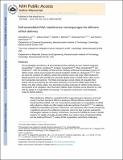| dc.contributor.author | Lee, Jong Bum | |
| dc.contributor.author | Hong, Jinkee | |
| dc.contributor.author | Bonner, Daniel K. | |
| dc.contributor.author | Poon, Zhiyong | |
| dc.contributor.author | Hammond, Paula T | |
| dc.date.accessioned | 2014-11-05T20:45:18Z | |
| dc.date.available | 2014-11-05T20:45:18Z | |
| dc.date.issued | 2012-02 | |
| dc.date.submitted | 2011-06 | |
| dc.identifier.issn | 1476-1122 | |
| dc.identifier.issn | 1476-4660 | |
| dc.identifier.uri | http://hdl.handle.net/1721.1/91470 | |
| dc.description.abstract | The encapsulation and delivery of short interfering RNA (siRNA) has been realized using lipid nanoparticles1, 2, cationic complexes3, 4, inorganic nanoparticles5, 6, 7, 8, RNA nanoparticles9, 10 and dendrimers11. Still, the instability of RNA and the relatively ineffectual encapsulation process of siRNA remain critical issues towards the clinical translation of RNA as a therapeutic1, 12, 13. Here we report the synthesis of a delivery vehicle that combines carrier and cargo: RNA interference (RNAi) polymers that self-assemble into nanoscale pleated sheets of hairpin RNA, which in turn form sponge-like microspheres. The RNAi-microsponges consist entirely of cleavable RNA strands, and are processed by the cell’s RNA machinery to convert the stable hairpin RNA to siRNA only after cellular uptake, thus inherently providing protection for siRNA during delivery and transport to the cytoplasm. More than half a million copies of siRNA can be delivered to a cell with the uptake of a single RNAi-microsponge. The approach could lead to novel therapeutic routes for siRNA delivery. | en_US |
| dc.description.sponsorship | National Institutes of Health (U.S.) (NIH) NIBIB Grant R01-EB008082) | en_US |
| dc.description.sponsorship | United States. American Recovery and Reinvestment Act of 2009 ((ARRA) grant) | en_US |
| dc.description.sponsorship | National Science Foundation (U.S.) (Division of Materials Research Polymers Program grant #0705234) | en_US |
| dc.description.sponsorship | David H. Koch Institute for Integrative Cancer Research at MIT (Nanotechnology grant) | en_US |
| dc.language.iso | en_US | |
| dc.publisher | Nature Publishing Group | en_US |
| dc.relation.isversionof | http://dx.doi.org/10.1038/nmat3253 | en_US |
| dc.rights | Article is made available in accordance with the publisher's policy and may be subject to US copyright law. Please refer to the publisher's site for terms of use. | en_US |
| dc.rights.uri | | en_US |
| dc.source | PMC | en_US |
| dc.title | Self-assembled RNA interference microsponges for efficient siRNA delivery | en_US |
| dc.type | Article | en_US |
| dc.identifier.citation | Lee, Jong Bum, Jinkee Hong, Daniel K. Bonner, Zhiyong Poon, and Paula T. Hammond. “Self-Assembled RNA Interference Microsponges for Efficient siRNA Delivery.” Nature Materials 11, no. 4 (February 26, 2012): 316–322. | en_US |
| dc.contributor.department | Massachusetts Institute of Technology. Department of Chemical Engineering | en_US |
| dc.contributor.department | Massachusetts Institute of Technology. Department of Materials Science and Engineering | en_US |
| dc.contributor.department | Singapore-MIT Alliance in Research and Technology (SMART) | en_US |
| dc.contributor.department | Koch Institute for Integrative Cancer Research at MIT | en_US |
| dc.contributor.mitauthor | Lee, Jong Bum | en_US |
| dc.contributor.mitauthor | Hong, Jinkee | en_US |
| dc.contributor.mitauthor | Bonner, Daniel K. | en_US |
| dc.contributor.mitauthor | Poon, Zhiyong | en_US |
| dc.contributor.mitauthor | Hammond, Paula T. | en_US |
| dc.relation.journal | Nature Materials | en_US |
| dc.eprint.version | Author's final manuscript | en_US |
| dc.type.uri | http://purl.org/eprint/type/JournalArticle | en_US |
| eprint.status | http://purl.org/eprint/status/PeerReviewed | en_US |
| dspace.orderedauthors | Lee, Jong Bum; Hong, Jinkee; Bonner, Daniel K.; Poon, Zhiyong; Hammond, Paula T. | en_US |
| dc.identifier.orcid | https://orcid.org/0000-0003-3243-8536 | |
| mit.license | PUBLISHER_POLICY | en_US |
| mit.metadata.status | Complete | |
